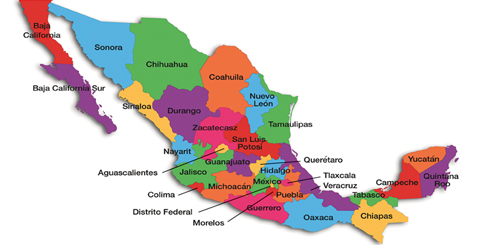The market is so sprawling and busy that it has its own police force and postal code, as well as numerous restaurants, gas stations, bank branches, government offices, and even its own soccer league.
According to some of the 300,000 daily visitors, it can take up to 15 minutes to cross the entire market in a taxi.
A Kaleidoscope of Climates
Mexico has seven distinct climate regions which can be divided into three groups: tropical, dry, and temperate, and each of these has its own microclimates.
Tropical regions have two micro-climates: tropical wet and tropical wet-and-dry. The former is found along the Gulf Coast in the states of Veracruz and Tabasco, as well as in Oaxaca and the highlands of Chiapas.
Tropical wet-and-dry differs in that it features an actual dry season; this category covers most of the country’s Pacific coastal area and the Yucatán Peninsula.
The two dry climates are arid, a desert climate that can experience freezing winters; and semi-arid, which receives more rain, mostly during the summer months.
Mexico’s arid regions include most of Baja California, parts of Sonora, and the northern reaches of the Central Plateau (Coahuila and Chihuahua).
A semi-arid climate covers the southern section of the Central Plateau, northern Yucatán, and interior regions as far south as Oaxaca.
Like Baby Bear’s porridge, the temperate climate is just right: not too hot, not too cold.
What differentiates the three different microclimates in this group is the amount of rainfall. Temperate with dry winters means low humidity and mild temperatures, much like the weather in many of Mexico’s mountainous areas and in Nuevo León, and the interior of Tamaulipas, which also has tropical weather in its coastal areas.
Less prevalent are the humid subtropical and Mediterranean climates. The former features more rainfall throughout the year and exists only in the eastern Sierra Madre and in a limited area in the southern mountain region.
A Mediterranean climate, similar to the California coast, and is unique to the area around Tijuana, which is dry during the summer months and gets all of its rain in winter.
A Cornucopia of Crops
Fresh produce is one of the mainstays of La Central and a key business for growers and companies on both sides of the border.
And while some observers wonder whether the growth in volume of Mexican produce means that new regions are coming into play, others like Art Salinas, sales manager at Pharr, Texas-based Bonanza 2001, believe current growers are simply expanding their reach.
“There aren’t really new regions,” explains Salinas, whose company grows avocados and hydroponic greenhouse tomatoes in Jalisco.
“They’ve always been there,” continues Salinas, “but now they’ve increased their acreage. Where someone had one hectare, now they have two and maybe another greenhouse.”



